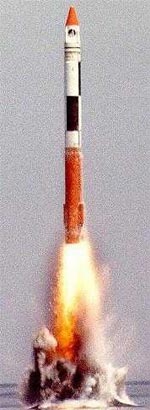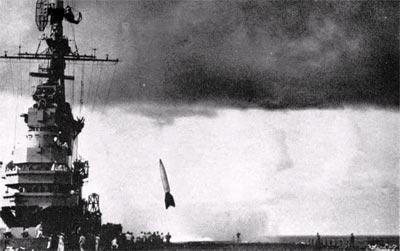Ocean-based launch: extending a successful approach to new applicationsby Andrew E. Turner
|
| The Sea Launch failure comes almost 60 years after the failure of the US Navy’s only attempt to launch a liquid fueled rocket from an aircraft carrier. |
The special design and dedicated functionality of the Sea Launch Odyssey platform appears to have spared it from the harm that worried Navy officials. Unlike the Midway, the converted oil-drilling rig launch platform has no crew on board during launch operations. It is of course speculative at this time, but the appearance of the failure suggests considerable launch infrastructure damage would have resulted had this been a land-based launch. The event and its aftermath appear to support the notion that ocean-based launch, if done correctly, provides a safe and effective path to space.
Low-cost ocean-based launch: float your rocket
The ocean-based launch model should enable Sea Launch to recover relatively quickly and return to efficiently launching large spacecraft toward GEO. This raises the question whether ocean-based launch has a role for small spacecraft, low-cost missions, and reusable payloads. How can we best apply the successful Sea Launch model to these exciting new applications?
To begin with, let’s briefly discuss applications of low-cost launch: sounding rockets for atmospheric research; rocket flight testing; tactical and test satellites; university-class pico- to microsats; water, food and propellant for the International Space Station; and, in general, low-cost supplies for exploration missions and other satellites. Low-cost launch benefits both established applications and new needs for the development of space.
The cost and sensitivity of the payloads for these research and re-supply missions is vastly lower than that of the high-end geosynchronous telecommunications satellites employed to broadcast the Super Bowl to millions of homes and other high-profile applications. For many of these low-cost payloads, ocean-based launch can be reduced to an even simpler and lower-cost infrastructure approach, that of floating launch. If something goes wrong during the launch of a vehicle bobbing in the water all by itself, there isn’t even a platform to damage.
Floating launch of rockets was demonstrated in the 1960s and early 1970s by Captain Robert Truax and Caprtin John Draim, both retired Navy officers. The US Navy’s Project Hydra, directed by Capt. Draim, involved the launch of more than 50 vehicles from the water. In 1984, the Dolphin vehicle was launched by Starstruck (later to become AMROC) from the Pacific Ocean off the California coast.
 August 3, 1984 launch of the Dolphin vehicle directly from the ocean. (credit: astronautix.com) |
The forgiving water launch infrastructure permits conscious relaxation of launcher reliability as a path to even lower launch cost for payloads that are easily replaceable and thus can tolerate some launch failures. This thinking gave rise to the Aquarius launch vehicle concept previously discussed here (See “The myth of heavy lift”, The Space Review, May 17, 2004, and “Low-cost launch and orbital depots: the Aquarius system”, The Space Review, January 30, 2006). Aquarius will ferry low-cost, replaceable supplies of water, air, food, and propellant to the International Space Station and propellant to other satellites, permitting higher-cost launchers to carry large spacecraft to orbit with nearly empty propellant tanks that will be topped off in space. This large, novel low-cost vehicle can also ferry low-cost small spacecraft to orbit economically, which can easily be produced in excess quantities to make up for losses due to the significant Aquarius launch failure rate.
Three R’s: recovery, retrieval and reuse
For sounding and test rocket missions, floating launch and recovery is attractive. Retrieval of the vehicle, sensor, and test article payloads for analysis and re-launch is relatively easy, with no obstacles and terrain problems between the mission crew and the recovery site. The rockets are far smaller than the multi-stage Sea Launch Zenit-3SL booster, facilitating handling of the vehicles using small ships and cranes.
| The forgiving water launch infrastructure permits conscious relaxation of launcher reliability as a path to even lower launch cost for payloads that are easily replaceable and thus can tolerate some launch failures. |
Launching the recoverable, easily refueled, reusable liquid-fuel sounding rocket from a floating condition avoids the need for a specialized, durable launch platform, provided payloads are low-cost. This eliminates a potential need for payload removal in the event of a launch scrub, which was a safety showstopper for the US Navy’s Sea Launch and Recovery (SEALAR) program in the 1990s, which involved floating launch and water landing.
With proper design, “landing” in the water at modest velocities is benign, and supports rapid recovery and reuse with no need for refurbishment due to ground impacts. This could enable multiple flights per day for research rockets.
The use of floating launch and water recovery would have prevented the loss of Armadillo Aerospace’s Pixel vehicle on October 21, 2006 and the loss of the DC-X ten years earlier. Both of these craft tipped over when flying at low altitude and suffered hard impacts with the ground that caused irreparable damage. On the other hand, the US Navy’s Hydra 1 vehicle was permitted to fall from a significant height into the lagoon at Pt. Mugu, California after a successful floating launch on March 18, 1960 and was subsequently retrieved and re-flown. Hydra 1’s straight up and down flight was enabled by floating launch: if it had been launched from a platform, it would have a suffered a catastrophic collision with the platform following descent.
Pelican: resuming floating launch research
Space Systems/Loral (SS/L), in cooperation with its partners Interorbital Systems, Microcosm, Professor Robert Twiggs and his laboratory at Stanford University, and Capt. John E. Draim, USN (Ret.), has submitted a proposal for US Government funding for the development of Pelican, a small liquid-fueled reusable floating launch sounding rocket. Unlike nearly all of today’s sounding rockets, Pelican will be easily refueled and re-launched within a short span of time without replacing any part of its structure or requiring extensive servicing. While Pelican would initially demonstrate the flight stabilization concept that enables large floating launch vehicles like Aquarius, it could become a useful research and operational vehicle in its own right.
| Unlike nearly all of today’s sounding rockets, Pelican will be easily refueled and re-launched within a short span of time without replacing any part of its structure or requiring extensive servicing. |
Interorbital Systems would build and fly this vehicle; it holds an FAA license to perform floating launches from the Pacific and has flown a number of land-based sounding rockets from the Mojave Desert. The new problem of maintaining guidance and control of a vehicle which is sufficiently “tail-heavy” to float stably when it is upright in the water and yet must fly in this aerodynamically unstable orientation through the atmosphere will be addressed by SS/L and Prof. Twiggs’ team. SS/L holds a US patent on the forward-and-aft controller that will be used to actively stabilize Pelican during flight. Microcosm has extensive sounding rocket experience from its Project Scorpius, including vehicle structure from its composite materials development program.
Pelican paves the way to responsive launch of re-usable sounding rockets, which can achieve altitudes in near-Earth space far more rapidly than balloons or aircraft, returning samples or test articles to the ground in a matter of minutes.
Conclusion
We have discussed several ways forward involving ocean-based launch in this article, from the proven platform-launched high-end Sea Launch Zenit-3SL, capable of carrying top-of-the-line commercial telecommunications satellites, down to low-cost reusable sounding rockets and low-cost launch of supplies and other replaceable payloads. Sea Launch’s previous success in launching five large geosynchronous spacecraft in 2006 rivals the success rate of all other commercial launchers. Pelican and Aquarius pave the way to platform-less floating launch of low-end payloads for atmospheric research, reusable sounding rockets, and the eventual economical launch of supplies and low-cost microsats. Launch rates for these new vehicles will be far higher and schedules more flexible and responsive than any launcher in place today, supporting broader and more beneficial use of space.
